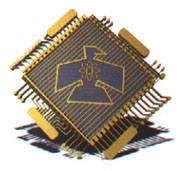
 |

|
|
 |
|
|
|||
 |
Concordia’s Native Access to Engineering Program (NAEP), Indian and Northern Affairs Canada, and IBM Canada this week announced a joint, federally-funded project that will distribute interactive high school material in math and science subjects to aboriginal students across Canada via the Internet. The project is aimed at interesting more First Nations students in engineering careers, and at giving them some of the skills they need to succeed in that field. The announcement was to be made during Dream-Catching 2001, a three-day professional development conference that started yesterday at Concordia for people who teach math and science to aboriginal students. NAEP, administered by the Faculty of Engineering and Computer Science, was founded in 1993 by Corinne Mount Pleasant-Jetté, a member of the Tuscarora nation, and professor of technical writing at Concordia. Jetté and NAEP coordinator Dawn Wiseman try to make aboriginal students more aware of engineering by organizing summer camps, participating in career fairs, and speaking to native community leaders. “Engineering develops critical thinking,” said Jetté, adding that, as native communities move forward on land claims, they need people with expertise in fields like resource and infrastructure management, and computer technology. One problem is that engineering has not been promoted very well. Also, some people who teach math and science in native communities are not specialists in those subjects, so they are not familiar with engineering. In order to choose this field, native students have to be made aware of its diverse applications, and of the qualifications and skills they need to study it. Another goal of NAEP is to make engineers aware of the huge population of aboriginal young people in Canada (65 per cent of the native population are under age 21), some of whom could be future engineers. Wiseman’s main duty is to develop curriculum content for a Web site (www.nativeaccess.com) that familiarizes high school teachers and students with various areas of engineering in ways that relate to native culture or that could be used to solve problems facing native communities. The Web site includes a newsletter, worksheets, puzzles, teachers’ guides and profiles of native people who have succeeded in careers in science or engineering. IBM has been the corporate sponsor of this project. Other sponsors include DIAND, Industry Canada, HRDC, NRC, NSERC, Natural Resources Canada, Syncrude, the Ordre des Ingénieurs du Québec and Concordia faculty. The new three-year project will give the Web site interactive capability so, for example, native students can talk on-line about science and engineering topics with students in another community, or ask questions through the Internet of native role models like architect Douglas Cardinal. NAEP will provide the content, while IBM will provide the technical expertise to make it animated and interactive. As part of a feasibility study, NAEP and IBM surveyed students and teachers on reserves and in native communities. They also looked at the types of equipment and Internet access available. Although equipment and access speed vary, all the schools surveyed have access to the Net, with schools in the far north being totally wired, Wiseman said. She suggested NAEP isn’t the kind of project that can turn out large numbers of engineers within the first five years. It is part of an overall effort to encourage aboriginal young people to stay in school, not drop math and science courses, and continue on to post-secondary education. However, Jetté noted, about one First Nations person a year has graduated in engineering from Concordia over the last six years, and several others are currently enrolled in the Faculty. This project fits well with Concordia’s tradition of encouraging first-generation post-secondary education. She added that the university has worked closely with the Cree and other aboriginal communities, notably through training programs in business and community health, and that native people feel welcome here.
|
|